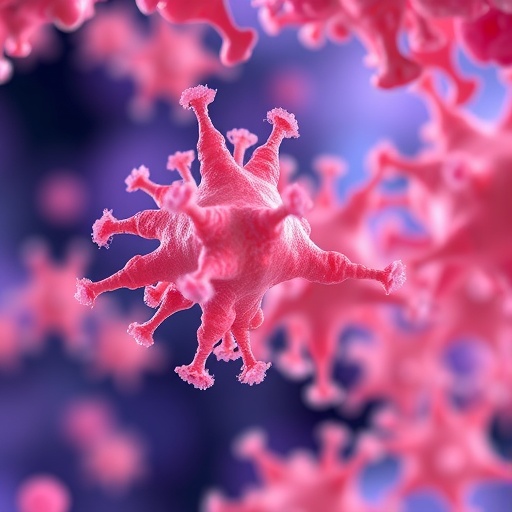In a groundbreaking study published in Science Advances, researchers from the University of Liverpool have delineated the intricate molecular choreography behind the assembly of Eut microcompartments—specialized proteinaceous organelles that pathogenic bacteria utilize to metabolize ethanolamine, a plentiful nutrient within the gastrointestinal tract. These microcompartments, pivotal for bacterial survival and virulence, represent a sophisticated biological adaptation allowing pathogens not only to endure but to flourish in the nutrient-competitive environment of the gut.
Through a comprehensive, multidisciplinary approach combining super-resolution fluorescence microscopy, genetic manipulation, structural biology, biochemical assays, and computational modeling, the team unmasked the sequential events and protein interactions indispensable for Eut microcompartment biogenesis in Salmonella. This research unravels the molecular infrastructure, revealing how bacteria precisely construct a protective protein shell before encapsulating the enzymatic machinery necessary for ethanolamine catabolism.
The study illuminates a central role for a previously enigmatic protein, EutQ, which functions as a crucial molecular scaffold orchestrating the integration of catabolic enzymes within the shell. Disruption of EutQ expression precipitates a catastrophic failure in microcompartment assembly, severely impairing bacterial growth. This finding spotlights EutQ as a potential Achilles’ heel, a novel target for antimicrobial strategies aimed at undermining pathogen metabolism by disarming their nutrient-utilization organelles.
Intriguingly, the enzyme cargo inside the developed microcompartments exhibits properties reminiscent of liquid-like condensates—dynamic, phase-separated entities that facilitate enhanced catalytic efficiency through transient interactions and molecular mobility. This behavior contrasts with static enzyme aggregates, suggesting evolutionary optimization to maximize metabolic flux within the spatial constraints of the organelle.
Ethanolamine itself is a bifunctional nutrient, providing both carbon and nitrogen sources, and is generated abundantly in the gut through membrane phospholipid turnover. Its bioavailability fosters a competitive advantage for pathogens capable of exploiting it, notably Salmonella, a significant cause of foodborne illness worldwide. By elucidating the molecular logic enabling ethanolamine utilization, this study expands the understanding of how bacterial pathogens adapt metabolically to niche environments within the host.
At the heart of the assembly process is the protein shell, a semi-permeable nano-container composed of hexameric and pentameric protein complexes. The shell not only physically segregates toxic intermediates produced during ethanolamine metabolism but also selectively regulates metabolite flux, preserving intracellular homeostasis while enabling efficient nutrient catabolism.
The insights from this research transcend bacterial physiology, offering a template for engineering synthetic microcompartments with bespoke functionalities. Leveraging nature’s design principles, synthetic biologists can aspire to construct artificial organelles capable of compartmentalizing complex biochemical reactions, with applications spanning biotechnology and medicine.
Dr. Mengru Yang, the study’s first author, emphasized the novelty of these findings: “While the existence of bacterial microcompartments was known, the precise molecular sequence orchestrating their assembly and the dynamic behavior of encapsulated enzymes were previously elusive. Observing these protein condensates actively facilitate organelle formation opens new horizons in cell biology and microbial pathogenesis.”
Corresponding author Professor Lu-Ning Liu underscores the translational impact: “This work not only deepens fundamental knowledge of bacterial microcompartment assembly but also paves new avenues to disrupt pathogen metabolism. Targeting the assembly factors and enzymatic sequestration mechanisms could foster innovative antimicrobial therapies, crucial amid rising antibiotic resistance.”
The team intends to extend their exploration to analogous microcompartments in other clinically relevant bacteria, investigating conserved and divergent assembly pathways. Next steps include atomic-level structural characterization of key protein interfaces and functional assays to test inhibitors that could thwart organelle formation, thereby attenuating bacterial virulence.
Supported by the Biotechnology and Biological Sciences Research Council (BBSRC), this collaborative effort also includes scientists from Huazhong Agricultural University and Ocean University of China, underscoring the global impetus to decode microbial adaptations that underpin infectious disease.
By charting the molecular blueprint for Eut microcompartment biogenesis, this study represents a significant leap in microbiology, marrying advanced imaging techniques and molecular biology to unravel the complexities of bacterial organelle construction. Such knowledge enhances our understanding of microbial metabolism and opens promising frontiers in combating bacterial infections through targeted disruption of essential cellular machinery.
Subject of Research: Cells
Article Title: Molecular basis of the biogenesis of a protein organelle for ethanolamine utilization
News Publication Date: 1-Oct-2025
Web References: https://dx.doi.org/10.1126/sciadv.adx9774
Image Credits: Professor Lu-Ning Liu, University of Liverpool
Keywords: Structural biology, Biochemical processes, Biochemical analysis, Biomolecules, Protein functions




